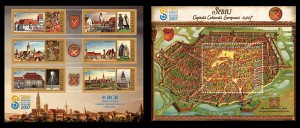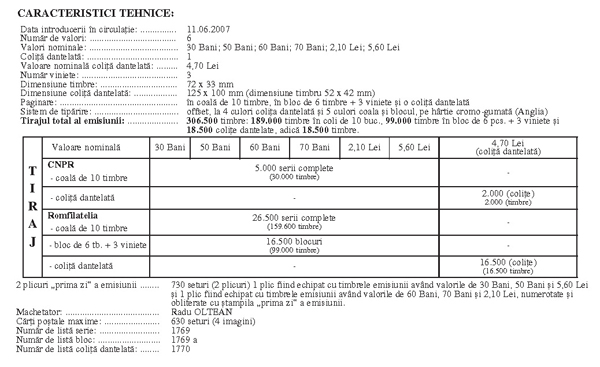 Romfilatelia, the specialized company in editing and trading
Romfilatelia, the specialized company in editing and trading
Romanian postage stamps, joining important cultural events which take
place in 2007 in Sibiu, European Capital of Culture, achieved a philatelic
issue dedicated to this major event, of national significance: SIBIU –
EUROPEAN CAPITAL OF CULTURE 2007.Romfilatelia, the specialized company in editing and trading
Romanian postage stamps, joining important cultural events which take
place in 2007 in Sibiu, European Capital of Culture, achieved a philatelic
issue dedicated to this major event, of national significance: SIBIU –
EUROPEAN CAPITAL OF CULTURE 2007.
In May 2004, in the Assembly of the Culture Ministers from the EU
member states, held for the first time in “a 25 format” in Brussels, the
Council of Ministers appointed the cities of Luxemburg and Sibiu as
European Capitals of Culture in 2007.
The election of Romania to elaborate an international project of this
importance – being the first Eastern European country to organize an
European Capital of Culture, after the extension of the European Union,
as well as the first with which an Eastern-Western partnership is set up,
represents for us a chance to introduce the Romanian people with new
and multiple bonds, tightly connected to its history and with the common
cultural traditions with the other European nations.
With its paved streets and houses built in a Saxon style, the city of
Sibiu (Hermannstadt), first attested in a document in 1191, is a true
outdoor museum. At each step you meet history, with the tours of
medieval fortress, with the monumentality of the churches or with the
uniqueness and special value of the exponents in the biggest outdoor
museum in Europe, Astra Museum.
But Sibiu also offers national or world premieres such as: the first
Romanian hospital (1292), the first country pharmacy (1494), the first
paper mill (1534), the first lightning rod in South-East Europe (1795),
the first homeopathic lab in the world (1797), the first Romanian
Museum – Brukenthal (1817), The Liars Bridge (or The Bridge of Lies)
(1859) – the oldest metal bridge in the country, the second city (after
Timisoara) in Europe to introduce the electric tram (1904), the first Zoo
in Romania, built in 1928.
Sibiu, the city of the year 2007 represents Romania through its
traditions, architecture, music, theatre, through Cioran, Blaga or Goga,
or through the multiple exhibitions and cultural manifestations.
Sibiu´s culture is transmitted through art and creation language,
appearing as a true artistic mirror of Romania, in which the hospitability
of the people of Sibiu is reflected and known to the entire Europe.
The stamps of the philatelic issue highlight époque images of
monuments representative of the old Sibiu.
On the stamp with the face value of RON 0.30 we find the image of
the Old City Hall – Altemberger House, after the name of the Mayor in
whose era the building started to be erected in the current form representing
the most important Gothic civil architecture complex in Transilvania.
The oldest part of the building is the tour-dwelling, Thomas Altemberger,
mayor of the city between 1470 and 1491, starting the construction at the
end of the 15th century. Together with the image of the Old City Hall on
the stamp there is illustrated a detail, “Knights” from the altar of the fortified
church (15th century) in Dupus, attested in a document in 1267.
On the stamp with the face value of RON 0.50 we find two renowned
travel spots, the Liars´ Bridge and the Council Tour. The oldest metal
bridge (of cast iron) in Romania, i.e. the Reclined Bridge as it is called,
was built in 1859, and the name of the Liars´ Bridge is connected to the
lies told by people who set on the benches, at gossip, near the bridge. The
Council Tour represents the symbol of Sibiu and is for the first time
mentioned in 1370, together with the building where the “city council”
assembled, from which it got the name that it carries today. On the same
stamp a drawing which represents two 18th century Transylvania Saxons
can also be found.
On the stamp with the face value of RON 0.60 the Parochial
Evangelic Church known under the name of the Evangelic Cathedral is
depicted. The Gothic cathedral was built in the 14th century. The year of
initiation of the construction of the 73 m tour is known, being 1371.
Although a series of cultural golden silver vases are not accessible to the
public, the pieces exhibited are highlighted through richness, originality,
diversity and special artistic value. In the church there is also one of the
most beautiful bronze baptismal fonts in the country, the work of the
master Leonhardus from 1438. The organ was built in 1672. On the same
stamp a detail of the church painting is also reproduced representing the
Crucifixion, a 15th century painting.
On the stamp with the face value of RON 0.70 a panoramic image of
the Grand Square at 1780 is shown. This square is located in the historical
center of Sibiu and was attested for the first time as a cereal market in a
1411 document. Across time, this place was used for meetings but also for
public executions. The market has 142 m length and 93 m width, being
one of the biggest in Transylvania. The south side was declared
architectural monument. On the same stamp we can also find the image
of peasants from Marginimea Sibiului with their traditional costumes,
reproducing an 18th century drawing.
On the stamp with the face value of RON 2.10 the Brukenthal
Palace and the Saint Nepomuk Statue around 1935 are depicted.
Brukenthal Palace is one of the most important Baroque style monuments
in Romania, built in stages, between 1778-1788, to serve the baron Samuel
von Brukenthal as an official residence and to shelter its collections,
which can be visited in 1790, three years before the opening of the
Louvre Museum in Paris. The Baroque halls, the reception spaces and
musical soirees, preserve the original pieces of the Palace: the stoves in
Rococo and Neoclassical style, the red silk and wallpapers painted in oriental
style, the Murano glass chandeliers and 18th century Transylvanian furniture
pieces. Brukenthal Museum was officially opened in 1817, thus being
the oldest Central European Museum. The statue of Saint Martyr Johannes
Nepomuk, built in 1734, rests nowadays in the yard of the parochial
house of the Catholic Church from the Great Square. On the same stamp
we find illustrated the portrait of the baron Samuel von Brukenthal
(1721-1803), governor of Transilvania in the period 1777-1787.
On the stamp with the face value of RON 5.60 a Panoramic image
of Sibiu from 1790 – after a painting, made by F. Neuhauser is
depicted. Along with this, on the stamp the Cisnadie Gate Tour is also
illustrated, in a J. Böbel watercolor.
On the philatelic souvenir sheet is illustrated a reproduction of the
Sibiu Fortress from the middle of the 17th century.
Issue date: 2007-06-11



